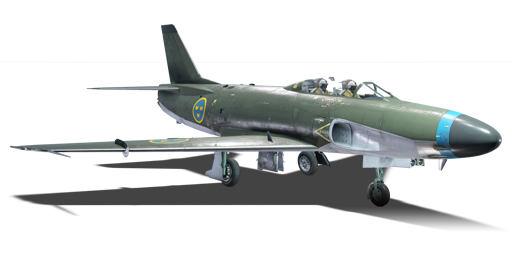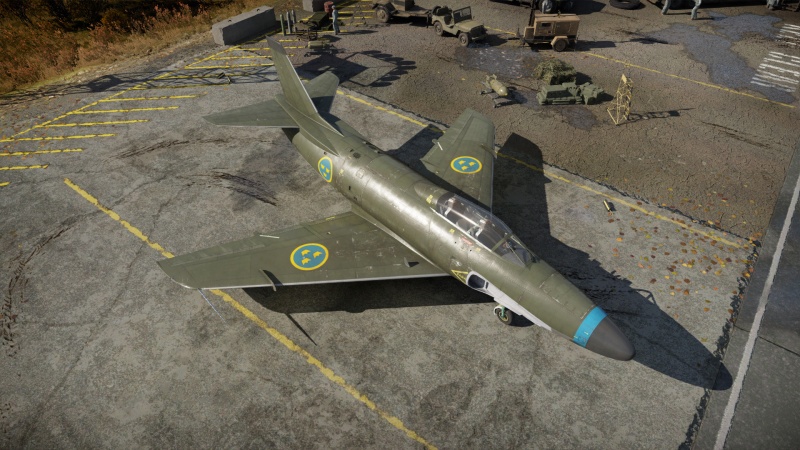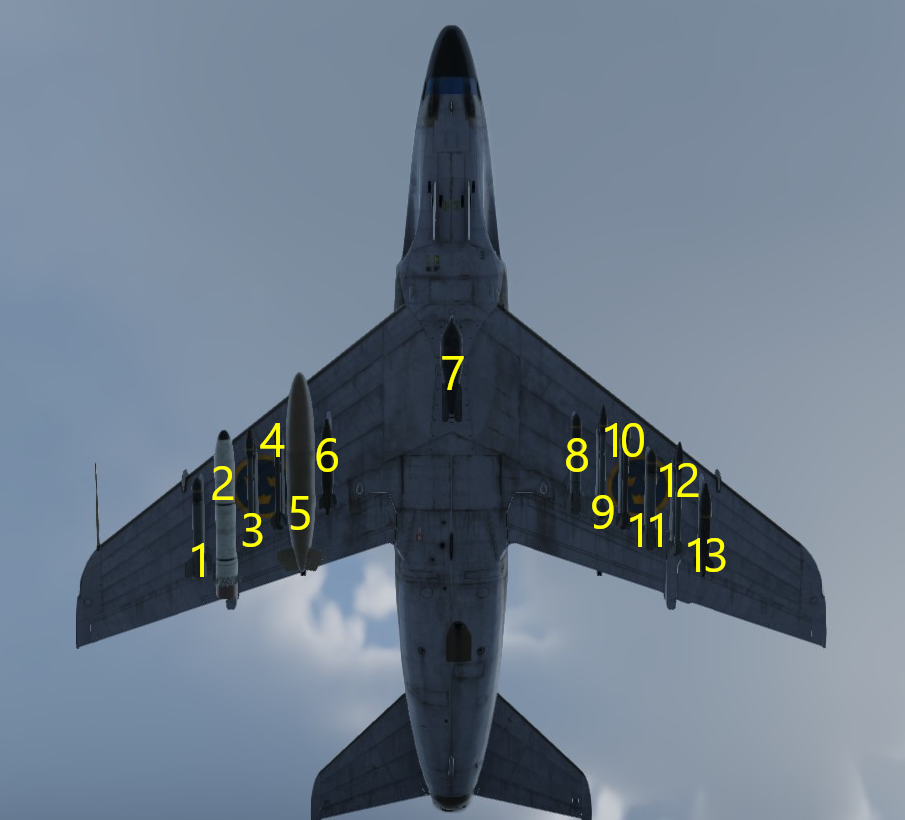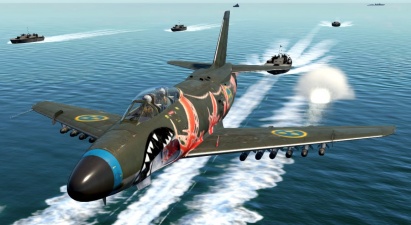A32A
| This page is about the Swedish strike aircraft A32A. For other versions, see SAAB 32 Lansen (Family). |
Contents
Description
The A32A was designed and developed by the Swedish company SAAB. Development began in 1948 and it first flew in 1952. Deliveries to the Swedish air force, Flygvapnet, began in 1954. In Flygvapnet, it was used as a ground-attack aircraft, being able to carry a large array of different bombs and unguided rockets as well as four 20 mm Akan m/49 cannons. It remained in service until 1978 but never saw use in combat. Powered by a license-built Rolls-Royce Avon engine, locally designated the RM5, it was able to break the sound barrier in a dive, thus becoming the first Swedish aircraft to fly faster than the speed of sound.
Introduced in Update 1.95 "Northern Wind", the SAAB A32A Lansen is a very slow and janky aircraft. But since it is an attacker, it does not need great agility. It has ballistics computers for bombs, rockets, and its cannons. In air RB/SB, it can use its 600 kg mb m/50 bombs to destroy a full base, or destroy several ground targets in air RB. It lacks flares but it has access to two chaff pods, which may be useful against early SARH missiles. Unlike the J32, it lacks missiles, but it can still be used in air to air combat, its radar is quite powerful and can be used to locate targets through clouds and fog, and its four 20 mm cannons have a very decent ammo pool. It also has good energy retention so you can energy trap MiG-21s and other delta wing fighters with ease.
General info
Flight performance
The aircraft is powered by a Svenska Flygmotor RM5A turbojet engine, a licensed version of the British Rolls-Royce Avon Mk 21A TRD. The engine develops 3,420 kgf in normal operation and 4,630 kgf on afterburner, a very mediocre performance for such a large attack aircraft. With a full bomb load the airplane barely breaks away from the runway surface and cannot accelerate above 780 km/h. Even after jettisoning the suspended armament, the maximum speed increases to only 1050 km/h. In addition, at high altitudes, engine efficiency is significantly reduced, so do not try to climb above three kilometres - most of the opponents will be much higher anyway. It is better to gain maximum speed near the ground and then spend it as sparingly as possible, and in no case try to run away from the opponents at altitude. Needless to say, almost any potential opponent will be much faster than the Swedish Striker.
The aircraft's arrow-shaped wing has a large area and advanced mechanization, which means low stall speed and good stability at low speeds. Also a large area of ailerons as if disposes to active maneuvering, but let down the stabilizer - it loses its effectiveness at speeds above 600 km / h and does not allow you to conduct active maneuvering. But, thanks to limited rudder thrust and competent centering, the aircraft almost never reaches critical angles of attack, as, for example, MiG-21 or J35D. Because of this, and the low aerodynamic drag of the airframe, the airplane keeps energy very well. This feature can allow you to roll over opponents who have lost energy, and in case of failure, quickly retreat before the enemy has time to regain speed.
As a result, when playing the A32A, you should not rely on the aircraft's LTX. After all, the priority for an attack aircraft is armament, and here it is really good.
| Characteristics | Max Speed (km/h at 0 m - sea level) |
Max altitude (metres) |
Turn time (seconds) |
Rate of climb (metres/second) |
Take-off run (metres) | |||
|---|---|---|---|---|---|---|---|---|
| AB | RB | AB | RB | AB | RB | |||
| Stock | 1,088 | 1,084 | 12500 | 34.6 | 35.6 | 44.7 | 41.8 | 900 |
| Upgraded | 1,101 | 1,094 | 33.6 | 34.0 | 66.2 | 55.0 | ||
Details
| Features | |||||
|---|---|---|---|---|---|
| Combat flaps | Take-off flaps | Landing flaps | Air brakes | Arrestor gear | Drogue chute |
| ✓ | ✓ | ✓ | ✓ | X | X |
| Limits | ||||||
|---|---|---|---|---|---|---|
| Wings (km/h) | Gear (km/h) | Flaps (km/h) | Max Static G | |||
| Combat | Take-off | Landing | + | - | ||
| 1160 | 450 | 524 | 491 | 320 | ~11 | ~5 |
| Optimal velocities (km/h) | |||
|---|---|---|---|
| Ailerons | Rudder | Elevators | Radiator |
| < 850 | < 600 | < 600 | - |
Engine performance
| Engine | Aircraft mass | ||||||
|---|---|---|---|---|---|---|---|
| Engine name | Number | Basic mass | Wing loading (full fuel) | ||||
| Svenska Flygmotor RM5A | 1 | 8,322 kg | 297 kg/m2 | ||||
| Engine characteristics | Mass with fuel (no weapons load) | Max Gross Weight | |||||
| Weight (each) | Type | 13m fuel | 20m fuel | 30m fuel | 44m fuel | ||
| 1,350 kg | Afterburning axial-flow turbojet | 9,151 kg | 9,568 kg | 10,191 kg | 11,084 kg | 12,992 kg | |
| Maximum engine thrust @ 0 m (RB/SB) | Thrust to weight ratio @ 0 m (WEP) | ||||||
| Condition | 100% | WEP | 13m fuel | 20m fuel | 30m fuel | 44m fuel | MGW |
| Stationary | 3,424 kgf | 4,633 kgf | 0.51 | 0.48 | 0.45 | 0.42 | 0.36 |
| Optimal | 3,424 kgf (0 km/h) |
4,908 kgf (1,160 km/h) |
0.54 | 0.51 | 0.48 | 0.44 | 0.38 |
Survivability and armour
The airframe itself does not have a high survivability: the airplane, of course, can survive a machinegun burst or a couple of hits from a Soviet 23 mm cannon, but no more than that. The spars in the wings are quite fragile and are destroyed by several hits from air cannons and strong negative overloads. A downside is also its large profile, which greatly simplifies the enemy shooting at the machine.
In the fuselage and wings are installed treaded fuel tanks, which are quite rarely set on fire. Two pilots, fire suppression system and blocks of dipole reflectors also contribute to the survivability of the aircraft. The cockpit is protected by 5 to 15 mm thick armour, as well as 50 mm armoured glass, but this protection is enough for a few fragmentation shells, and armour-piercing 12.7 and 20 mm shells will easily penetrate this armour.
On the A32A, it is definitely not worth taking risks: any damage to the control surfaces or internal components of the machine immediately affects the controllability and control of the aircraft, which forces to withdraw from the battle and return to the airfield.
Modifications and economy
Armaments
| Ballistic Computer | |||
|---|---|---|---|
| CCIP (Guns) | CCIP (Rockets) | CCIP (Bombs) | CCRP (Bombs) |
| |
|
|
|
Offensive armament
The A32A is armed with:- 4 x 20 mm Akan m/49 cannons, nose-mounted (180 rpg = 720 total)
The 4 x 20 mm Akan m/49 cannons, which are a development of the Akan m/45, are mounted in the nose of the airplane. The cannons have a good rate of fire of 770 rounds per minute and a total ammunition capacity of 720 rounds, 180 per barrel. The cannon shells have good ballistics and low dispersion, which allows for effective fire at ranges up to 900 m, but insufficient damage does not allow to shoot down planes from several hits, forcing to shoot long bursts.
The following belts are available for the Akan m/49:
- Standard - a mixed tape, not bad against both air and ground vehicles;
- Ground targets - the tape is ineffective against aerial targets, and 38 mm armour-piercing shell penetration will not be enough to destroy armoured vehicles;
- Air targets - the most preferred tape against enemy aircraft and lightly armoured SAMs. The high-explosive shells are very effectively “sawing” planes, while the armour-piercing shells can easily deal with various lightly-armoured IFVs, BMPs or light tanks.
Suspended armament
The A32A can be outfitted with the following ordnance:
| 1 | 2 | 3 | 4 | 5 | 6 | 7 | 8 | 9 | 10 | 11 | 12 | 13 | ||
|---|---|---|---|---|---|---|---|---|---|---|---|---|---|---|
| 120 kg sb m/61 bombs | 1 | 1 | 1 | 1 | 1 | 1 | 1 | 1 | 1 | 1 | 1 | 1 | ||
| 250 kg mb m/50 bombs | 1 | 1 | 1 | 1 | 1 | |||||||||
| 500 kg mb m/56 bombs | 1 | 1 | 1 | |||||||||||
| 600 kg mb m/50 bombs | 1 | 1 | 1 | |||||||||||
| Brandbomb m/58 incendiary bombs | 1 | 1 | 1 | |||||||||||
| hprak m/49 rockets | 1 | 1 | 1 | 1 | 1 | 1 | 1 | 1 | 1 | 1 | 1 | 1 | ||
| psrak m/49B rockets | 2 | 2 | 2 | 2 | 2 | 2 | 2 | 2 | 2 | 2 | 2 | 2 | ||
| srak m/51 rockets | 2 | 2 | 2 | 2 | 2 | 2 | 2 | 2 | 2 | 2 | 2 | 2 | ||
| Large calibre chaff | 464 | 464 | ||||||||||||
| Maximum permissible loadout weight: 1,850 kg | ||||||||||||||
| Default weapon presets | |
|---|---|
| |
For pilots are available:
Bombs
- 12 x 120 kg mb m/61 bombs - almost useless for hitting moving targets, requires jewel-like precision from the pilot;
- 5 x 250 kg mb m/50 bombs - a set for skillful pilots who are able to throw bombs as accurately and close to targets as possible.
- 3 x 500 kg mb m/56 bombs - not recommended due to the lower explosive quantity compared to the 600 kg m/50, while the same number of bombs can be hung on the aircraft;
- 3 x 600 kg mb m/50 bombs - a bomb that has proven itself on the B18B and A21A-3 due to its impressive TNT equivalent and large destruction radius. It is excellent at destroying bases and concentrations of ground vehicles;
- 3 x 500 kg Brandbomb m/58 incendiary tanks - useless against armoured vehicles, and one base requires as many as four discharges, besides, the incendiary mixture extinguishes very quickly before it can cause significant damage.
Rockets
- 24 x 14.5 cm psrak m/49B rockets - shaped charge rockets with 500 mm penetration, most effective against enemy armoured vehicles, but requires accuracy or multiple hits - difficulty is the location of rockets along the wings;
- 24 x 15 cm srak m/51 rockets - high-explosive rockets with 4.5 kg of TNT. Almost useless against all armoured vehicles with closed fighting compartment;
- 12 x 18 cm hprak m/49 rockets - slightly more powerful high-explosive rockets with 5.25 kg TNT. To destroy an enemy tank you need to hit exactly the roof of the turret or hull.
For air battles it is recommended to take three 600 kg bombs - enough to destroy one base. For ground battles, you can take 5 x 250 kg bombs - that's five potential knockouts, or load three 600 kg bombs - cheap and angry. From unguided rockets it is worth taking shaped m/49B - they can penetrate any armour on these combat ratings, and the overpressure will destroy open vehicles with one hit.
Usage in battles
Air realistic battles
In Air RB you can take three 600 kg bombs - their total TNT equivalent is enough to destroy one base. Also take fuel for 30 minutes of flight, because most of the time you will have to fly with the afterburner on. After dropping bombs, you can return to the airfield, or try your luck against enemy aircraft. In this case, the use of the airplane is very similar to the use of early jets - you have to rely on the gained energy and speed, and do not get involved in dogfights. Just get enough speed and look for inattentive or energy-depleted opponents. The airplane is very good at conserving energy, so you'll have a good chance even against sluggish opponents like Sabres and early MiG-21s, as long as you always leave yourself time to retreat. Don't be greedy and don't underestimate the enemy: if you let the enemy pass you forward due to your own negligence, you won't be able to throw him off your tail. Even if you are far away from the enemy, it does not mean that you are safe. It is very likely that a missile will be fired at you, so it is worth looking around regularly.
Ground realistic battles
In Ground RB, the airplane reveals its best side. Powerful suspended armament and ballistic calculator allow you to destroy several targets in one run and hide from enemy SAMs. Due to the airborne appearance, thrust problems are negligible, and closer to the tank battlefield you will have a very good reserve of speed and energy.
When selecting a suspended weapon, it is important to understand the situation on and above the battlefield. If there are enemy planes in the sky and SAMs on the ground, then take 3 x 600 kg m/50s - you can quickly drop them and move back to safe lines. If there is no threat from air and ground, or you are a battle-hardened pilot, take 5 x 250 kg bombs. They require an accurate hit near the tank, but that's five potential destructions. After the first run, don't rush to turn around and build a second run - you'll lose all speed, and the weak engine won't allow you to get it back quickly. It is better to just fly around the tank map from the side where you are not expected and strike again.
Simulator battles
In EC, the airplane using as an attack aircraft. It destroys bases, bombs convoys and doing CAS. Due to its poor flight performance, the airplane has no anti-air potential in this mode. In ground simulation battles, the A32A get into two main setups:
In the first set-up, you will be threatened by SAMs with radar: ZSU-23-4 and ZSU-37-2. Dipole reflector blocks are good against them.
In the second set-up the enemy team will be equipped with SAMs, such as Strela-10M2 and 2S6, and the sky will be dominated by MiG-21SMT, F-5A and Su-25.
And if in the first case you can somehow fight with the enemy armoured vehicles avoiding enemy radars and SAM fire, then in the second case the outdated subsonic attack aircraft will have no chance against enemy SAMs and SPAAs.
Pros and cons
Pros:
- Good handling and stability at low speeds
- High kinetic energy efficiency
- Large payload of 1.5 tons
- Wide range of outboard weapons
- Ballistic computer
- Large ammunition for offensive armament
- Presence of chaff that prevent lock by enemy radars
Cons:
- Low thrust capability
- Poor maneuverability
- Fragile wing spars
- Large size
- Lack of guided weapons, especially air-to-air missiles
- No LTC to counter enemy infrared sensors
History
The A32A Lansen was the initial ground-attack variant of the Saab 32 'Lansen' attacker / fighter aircraft. Designed to replace the obsolete propeller-powered Saab 18, the aircraft's design was influenced by late-war German aircraft designs such as the P. 1101, P.1110, P.1111 and P.1112. The aircraft featured a conventional low-mounted swept-wing with a sleek fuselage housing a two-man crew, while the later J 32 fighter variant had a single crewmember. The A32A was introduced in 1955 with a total of 287 aircraft built for the attack role, serving until the end of the 1970s.
Following the end of the Second World War, the primary Swedish ground-attack aircraft was the obsolete Saab 18, a propeller-driven aircraft initially designed in the late 1930s. The initial design was influenced by late-war German aircraft designs such as the P. 1101, P.1110, P.1111 and P.1112, whose blueprints were given to Saab by former Messerschmitt engineers who fled to Switzerland. Among these engineers was Hermann Behrbohm, who would become a key contributor to the Saab 29, 32 and J 35 programs.
In terms of design, the A32A had a sleek fuselage with a low-mounted wing swept 35 degrees. The aircraft was powered by a Svenska Flygmotor RM5, which was a license-produced version of the Rolls-Royce Avon jet engine. This engine provided the A 32A with a thrust-to-weight ratio of ~0.3, while the later J32B fighter featured a heavily-upgraded RM6 engine producing significantly-more thrust. From the outset, the A32A was designed to house significant amounts of electronic warfare and weapons systems. The aircraft carried four 20 mm Oerlikon aircraft cannons in the nose, and could be fitted with unguided weapons including rockets and bombs up to 600 kg. The A32A could also carry two Rb 04 anti-ship missiles, one of the first cruise missiles to enter service.
In total, 287 A32A Lansens were produced for the Swedish Air Force between 1955 and 1957, replacing the Saab 18. The aircraft proved to be fairly reliable in service in terms of both aircraft and weapons systems. Additionally, the A32A was intended to carry nuclear weapons as part of Sweden's nuclear program; these plans were shelved with the end of Sweden's nuclear program. The A32A was Sweden's last dedicated ground-attack aircraft; the last airframes were phased out in the 1970s in favour of the AJ 37 Viggen.
Media
- Skins
- Images
- Videos
See also
- Related development
External links
| Swedish Aeroplane Company Ltd. (SAAB) | |
|---|---|
| Pre-SAAB: SA / ASJA | |
| SA 'Jaktfalken' | J6B |
| SAAB 17 | B17A · B17B · S17BS |
| SAAB 18 | B18A · B18B · T18B · T18B (57) |
| SAAB 21 | J21A-1 · J21A-2 · A21A-3 · J21RA · A21RB |
| SAAB 29 'Tunnan' | J29A · A29B · J29D · J29F |
| SAAB 32 'Lansen' | J32B · A32A · A32A Röd Adam |
| SAAB 35 'Draken' | J35A · J35D |
| SAAB 37 'Viggen' | JA37C · JA37D · AJ37 · AJS37 |
| SAAB 39 'Gripen' | JAS39A · JAS39C |
| SAAB 105 | SK60B · SAAB-105G |
| License Production | B3C (Ju 86K) |
| Export | SAAB-105OE · J35XS · ▄JAS39C · ◔JAS39EBS HU C |
| Sweden jet aircraft | |
|---|---|
| Fighters | J21RA |
| J29A · A29B · J29D · J29F | |
| J32B | |
| J34 | |
| J35A · J35D | |
| JA37C · JA37D | |
| JAS39A · JAS39C | |
| Strike aircraft | A21RB |
| A32A · A32A Röd Adam | |
| A28B | |
| AJ37 · AJS37 | |
| SK60B · SAAB-105G | |
| Export | SAAB-105OE |
| Finland | ▄Vampire FB 52A · ▄MiG-21bis · Saab J35XS |








